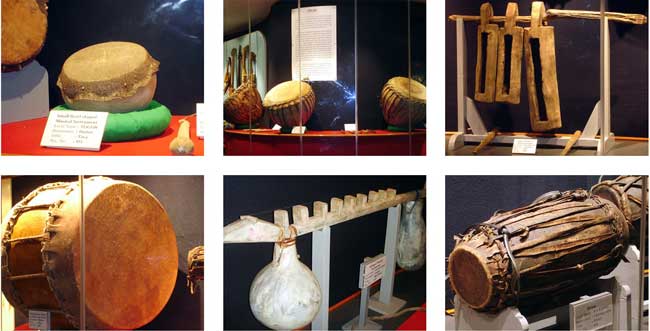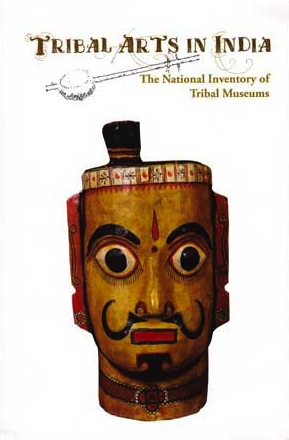
To view and learn more visit its Musical Instruments Gallery >>
More about Meghalaya >>
Garos are a tribal group from Meghalaya, predominantly residing in the Garo Hills region. Though found in the three (now five) Garo Hills districts, they also reside in the adjoining states of Assam, Tripura, Nagaland, and West Bengal in the Indian Union and across the political divide in the northern districts of Bangladesh.
Traditionally the Garos are agriculturists, and therefore much of their livelihood and religion revolved around it. Thus, various music (songs/incantations/ballads/prayers etc) forms a part and parcel of their livelihood. Additionally, various musical instruments are used not only as accompaniment to these songs and incantations, but also as symbols to various social occasion.
The Garos have a wide range of drums ranging from 4 feet 3 inches in length to the tiniest which is about 5 inch in length. They prefer the gambil (b. Careya arborica) wood for the frames of the drums. The wood is hollowed through with a sharp tool called batra which is made by the local blacksmith. However the construction of the drum is purely done by the Garos themselves. The drums are usually hung from the neck and played by both hands while dancing, and at times, they are placed on the ground and played while sitting.
There are different types of drums, the three major categories being the following: (a) Dama: This is the ceremonial drum used in different ceremonies and festive occasions. (b) Dama dalsang/ Kodoreng/ Nagra: It is a large drum consisting of an earthen pot covered with skin. This will be detailed in the final report. (c) Kram: This is the sacred drum. It has two other similar ones attached to it known as kram nadik and bitchimani bisa. Except for the nagra, kram, nadik and bitchimani bisa, all the other drums are kept in the bachelor’s dormitory (nokpante).
The Garos have different styles of playing the drum depending on the area they come from. They also have different players such as a single lead drummer called dadigipa, one accompanist or second drummer known as rikkakgipa and any number of bass drummers known as onlgrimgipa.
Source: National List for Intangible Cultural Heritage (ICH), Ministry of Culture, Government of India
URL: http://www.indiaculture.nic.in/national-list-intangible-cultural-heritage-ich
Date visited: 5 October 2020
[Bold typeface added above for emphasis]
Tips for using interactive maps
Toggle to normal view (from reader view) should the interactive map not be displayed by your tablet, smartphone or pc browser
For details and hyperlinks click on the rectangular button (left on the map’s header)
Scroll and click on one of the markers for information of special interest
Explore India’s tribal cultural heritage with the help of another interactive map >>

Read or download titles for free (eBooks & Magazine) >>
“The great diversity of music in India is a direct manifestation of the diversity and fragmentation of the population in terms of race, religion, language, and other aspects of culture. […] The songs vary in detail, not only from one region to another, but also within a region among the different strata of society.” – NA Jairazbhoy in “Tribal, Folk and Devotional Music” >>
“Religion is a personal matter and should not be politicised.” – Invitation by the Bharat Jodo Abhiyan (BJA) – a civil society platform involving organisations from across 15 states – extended to all like-minded citizens “who take pride in our progressive, inclusive civilization and are committed to our constitutional values of fraternity, liberty, equality and justice” | TheWire (2 January 2024) >>
State, Capital & Ethnographic museum
India’s ethnographic museums
Andhra Pradesh (Hyderabad) – Govt. of India | Please use the custom search field below for up-to-date information
Related posts about this state/region: www.indiantribalheritage.org >>
Assam (Dispur) – Govt. of India | Please use the custom search field below for up-to-date information
Related posts about this state/region: www.indiantribalheritage.org >>
Gujarat (Gandhinagar) – Govt. of India | Please use the custom search field below for up-to-date information
Related posts about this state/region: www.indiantribalheritage.org >>
Jharkhand (Ranchi) – Govt. of India | Please use the custom search field below for up-to-date information
Related posts about this state/region: www.indiantribalheritage.org >>
Kerala (Thiruvananthapuram) – Govt. of India | Kerala Institute for Research, Training & Development Studies of SC/ST (KIRTADS, Kozhikode) | Please use the custom search field below for up-to-date information Related posts about this state/region: www.indiantribalheritage.org >>
Madhya Pradesh (Bhopal) – Govt. of India | Please use the custom search field below for up-to-date information
Related posts about this state/region: www.indiantribalheritage.org
Maharashtra (Mumbai) – Govt. of India | Please use the custom search field below for up-to-date information
Related posts about this state/region: www.indiantribalheritage.org >>
Manipur (Imphal) – Govt. of India | Please use the custom search field below for up-to-date information
Related posts about this state/region: www.indiantribalheritage.org >>
Orissa / Odisha (Bhubaneshwar) – Govt. of India | Museum of Tribal Arts and Artifacts, SC/ST Research and Training Institute (Bhubaneshwar) | Please use the custom search field below for up-to-date information
Related posts about this state/region: www.indiantribalheritage.org >>
Rajasthan (Jaipur) – Govt. of India | Please use the custom search field below for up-to-date information
Related posts about this state/region: www.indiantribalheritage.org >>
Tamil Nadu (Chennai) – Govt. of India | Please use the custom search field below for up-to-date information
Related posts about this state/region: www.indiantribalheritage.org >>
Tripura (Agartala) – Govt. of India | Please use the custom search field below for up-to-date information
Related posts about this state/region: www.indiantribalheritage.org >>
Uttar Pradesh (Lucknow) – Govt. of India | Please use the custom search field below for up-to-date information
Related posts about this state/region: www.indiantribalheritage.org >>
West Bengal (Kolkata) – Govt. of India | Please use the custom search field below for up-to-date information
Related posts about this state/region: www.indiantribalheritage.org >>